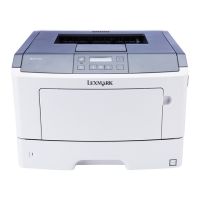To help avoid paper jams and poor print quality:
• Always use new, undamaged paper.
• Before loading paper, know the recommended printable side of the paper. This information is usually
indicated on the paper package.
• Do not use paper that has been cut or trimmed by hand.
• Do not mix paper sizes, types, or weights in the same tray; mixing results in jams.
• Do not use coated papers unless they are specifically designed for electrophotographic printing.
Selecting preprinted forms and letterhead
Use these guidelines when selecting preprinted forms and letterhead:
• Use grain long for 60 to 90 g/m
2
(16 to 24 lb) weight paper.
• Use only forms and letterhead printed using an
oset
lithographic or engraved printing process.
• Avoid papers with rough or heavily textured surfaces.
Use papers printed with heat‑resistant inks designed for use in xerographic copiers. The ink must be able to
withstand temperatures up to 230°C (446°F) without melting or releasing hazardous emissions. Use inks that
are not aected by the resin in toner. Inks that are oxidation‑set or oil‑based generally meet these requirements;
latex inks might not. When in doubt, contact the paper supplier.
Preprinted papers such as letterhead must be able to withstand temperatures up to 230°C (446°F) without
melting or releasing hazardous emissions.
Using recycled paper and other oce papers
As an environmentally conscientious company, Lexmark supports the use of recycled paper produced
specifically for use in laser (electrophotographic) printers.
While no blanket statement can be made that all recycled paper will feed well, Lexmark consistently tests papers
that represent recycled cut size copier papers available on the global market. This scientific testing is conducted
with rigor and discipline. Many factors are taken into consideration both separately and as a whole, including
the following:
Generally, the following property guidelines apply to recycled paper.
• Amount of post-consumer waste (Lexmark tests up to 100% post-consumer waste content.)
• Temperature and humidity conditions (Testing chambers simulate climates from all over the world.)
• Moisture content (Business papers should have low moisture: 4–5%.)
• Bending resistance and proper stiness means optimum feeding through the printer.
• Thickness (impacts how much can be loaded into a tray)
• Surface roughness (measured in Sheeld units, impacts print clarity and how well toner fuses to the paper)
• Surface friction (determines how easily sheets can be separated)
• Grain and formation (impacts curling, which also influences the mechanics of how the paper behaves as it
moves through the printer)
• Brightness and texture (look and feel)
4514-330
General information
29

